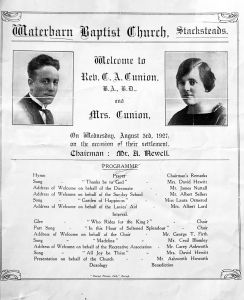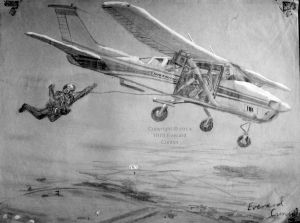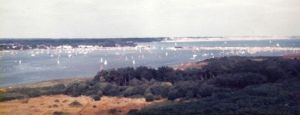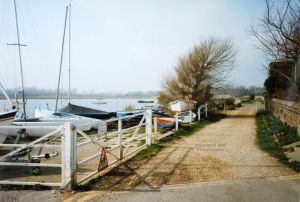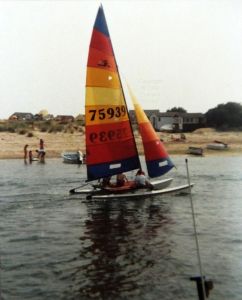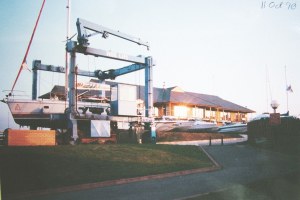Home (contents) → Miscellaneous → Miscellaneous photos
Miscellaneous photos
This page holds photos that do not belong in any of the other categories. At least, none that I could think of at the time.
Before I was born
For more of my father, see Miscellaneous photos, the 1960s.
Parachuting
I made my first jump at Shobdon airfield, Hereford, in April 1979. It was the inaugural jump of the Polytechnic of Wales (now the Treforest campus of the University of Wales) Parachute Club, which I founded.
I did more parachuting at Thruxton in Hampshire in 1982. I took this photo from beside the landing target at Thruxton airfield; a small sand pit. I do not know the parachutist’s identity. I recommend parachuting as a simple aviation activity.
Note the un-aerodynamic simple geometry of the ’round’ parachute canopy. Modern parachutes are rectangular and they resemble paragliders. (Paragliders were developed from ‘square’ gliding parachutes.) These round parachutes were, according to my instructors, originally emergency aircrew parachutes left over from the Korean War. You steered them by pulling on ‘toggles’ that distorted the two L-shaped slots in the canopy.
See also Airplane art and Miracle over Wisconsin, my painting of the 2013 skydiving collision.
I made most of my parachute drops, including my first, from a Cessna 206 – a fairly beefy single-engine monoplane with a high wing. Parachute lift modifications include removal of all the seats except the pilot’s seat and also the big cargo/passenger side door is absent. As a parachutist, while holding one hand over the deployment handle (rip chord) of your emergency reserve ‘chute to prevent its deployment handle snagging on anything, you climb aboard and kneel on the floor. Your main parachute, if you are a beginner like me, does not have a deployment handle. It has a chord connected to a shackle on the floor of the aircraft so it opens automatically when you are a fixed distance away.
For my first drop at one of those fields, I do not recall whether at Shobdon or Thruxton, I and my fellow parachutists were treated to the sight of the blue flashing lights of an ambulance, which show up really well at dusk, picking up someone with a broken leg…
The thought of crawling out onto the wing, through a hurricane of wind, clinging on to struts and wires hundreds of feet above the earth, and then giving up even that tenuous hold of safety and substance, left in me a feeling of anticipation mixed with dread, of confidence restrained by caution, of courage salted through with fear.
— from The Spirit of St. Louis, 1953, by Charles A. Lindbergh, first to fly solo across the Atlantic
The airplane lifts off in a roar of cold air and that big space of nothing by my right side where the cargo door would normally be and, at 300 feet above the ground, the jump master (next to the pilot) holds up three fingers and yells “Three hundred feet!” which you cannot hear because of the din. Below that, if the aircraft suffers a dire emergency, you stay with it because it is too low to jump safely. Above that, if the wings break off or something similar happens, you dive out the side. (See under External links later on this page for a video of just that happening.) Anyway, the kneeling position is OK for the first couple of minutes or so, but after the climb to over 2,000 feet and after several high-G turns, which the airplane has to do to get into position for the next person to jump, it is excruciating. (However, after a few jump lifts, I found I no longer noticed it.)
And if my main don’t open wide
I’ve gotta re-serve by my side.
And if that one should fail me too
Look out ground, I’m coming through.
😀
For an unusual rendition of the preceding, see under External links later on this page.
Fortunately, for my first jump, I was the nearest the door, that is, where the door would normally be, and therefore the first to jump. I could not wait to get out and relieve the pain in my knees. We had made a couple of high-G turns already while the jump master tossed out streamers to gauge the wind, which if too strong or variable could cause him to cancel the jump.
One bright morning at Thruxton, which occupies a slight rise in the landscape, the land around was covered in fog, although the airfield was clear. Tree tops and church spires protruded up out of the sunlit white layer, like something in a fanciful postcard. Only, a postcard is less exciting and does not cause your ears to pop with the reducing air pressure as the airplane climbs.
Here is a snippet from my still un-published novel:
Grassland, some of it flat, surrounded two thin grey lines crossing at an obtuse angle with tiny buildings clustered near them–the latter bearing no obvious relation to the enormous hangars and other structures that had surrounded him on the airfield–and white frost in the deeper hollows shone in morning sunlight. As best he could with the 5mph forward speed afforded by the old round parachute, he steered towards the target, a windsock in a sand pit with an army truck standing beside it. One moment he was slowly descending towards a flat expanse of pale green and the next moment frosty grass rushed up and he hit hard. His legs absorbed most of the energy of the impact – he missed the sand pit – and he rolled on the ground.
While at Shobdon airfield in April 1979, incidentally, Helen Chrestofi of Hereford Parachute Club repacked my hang glider emergency parachute for me. (See under External links later on this page for a bit about hang glider emergency parachutes.) I regard that in retrospect as a manifestation of my tendency in those days to get other people to do chores that are properly my own responsibility. I hope I have succeeded in overcoming that characteristic in succeeding years. (I carried out all subsequent 22 repacks of that parachute.) Helen did not seem to mind, however, remarking that it was an interesting experience, it being so different from a normal parachute.
On another light airplane flight (not parachuting) again in sunshine, we climbed into haze, which momentarily thickened around us and we were flying by instruments because of ‘white out’ – we were climbing towards a low winter afternoon sun. Suddenly we broke out into the clear and in front of us and all around was an alternative universe consisting of an infinite sheet of rippled snow. As we climbed above it, it became translucent grey and, looking down, you could see the green and winter brown-grey semi-urban landscape of Surrey below.
The perimeter track of Thruxton airfield is the famous motorcycle racing circuit. It was then used for racing about one day a week. However, glider towing, light aircraft and helicopter training were all carried out at the same time as parachute training. Some years later a woman parachutist was killed there by the rotors of a manoeuvring helicopter.
See also Parachute lift, my Hobby Craft 1/48th scale DHC-3 (U-1A) Otter.
Scenery

Cavalry parade on the approach to Hengistbury Head in about 1916. Photo from the Red House Museum print collection.
These photos are of low quality because I used a compact 110 format film camera.
The hill in the distance (behind the priory) in the second photo is where I taught myself to fly my kit-built standard Rogallo hang glider in 1974. The other side of that hill is Bournemouth airport…
In the summer of 1987, after a long period of unemployment, I started work (computer programming again) in central London. Travelling home to the south coast on Friday after work, if the weather was clear, I walked from whichever tube station to Waterloo main railway station. My route took me through the Barbican.
A week after I started work in London, my mother suffered a semi paralysing stroke (a blood clot in the brain). She was unable to walk or to speak properly thereafter. I spent my Saturday and Sunday afternoons (and holidays) wheeling her around the local area. I took this photo of a vintage boat with a 110 format camera that I carried with me.

Ferrying horses over ‘the run’ at Sandhills in about 1900. Photo from the Red House Museum print collection.

Testing my remote shutter release prior to going overseas for the first time in January 1989
The 3000 ft high ridge at Ager, Catalonia, Spain, creates its own weather. There is a plateau at the 2000 ft level used for paraglider training. CIVL is the hang gliding committee of the international aviation federation, but the abbreviation here is that adopted by the local hang gliding business.
See also Mainland Spain in My return to hang gliding, 1989.
I worked as a contract developer of computer-based training for a navy software house near Port Solent during the first Gulf war.
See also Aviation computer-based training.
The De Haviland Sea Vixen on display outside Revvo Castors (previously the De Haviland factory) in Christchurch was eventually vandalised and subsequently moved to a safer location.
When we moved to the south coast in about 1964, Christchurch airfield was still in use and I experienced my first flight from there. I was in the observer’s seat in an Auster light observation aircraft, used for ‘artillery spotting’ in World War 2. It was a grass field and I still recall the undulations of the aircraft on its take-off roll over the smooth but slightly humpy ground. As we climbed out, my young eyes were unaccustomed to the third dimension on that scale and my new perspective above the ground caused a curious optical illusion.
Rather than having any sensation of climbing I felt that the ground was sinking away from the airplane and a new landscape invisible from below was spreading out around us.
— from The Sky Beyond by Sir Gordon Taylor, 1963
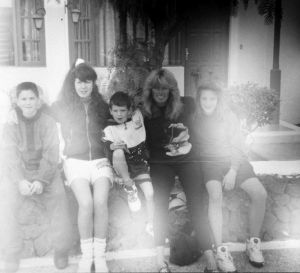
Singer Elkie Brooks, hang gliding instructor Rona Web, and others on Lanzarote, Canary Islands, in January or February 1993
The photo of Elkie, Rona, and others is of poor quality because light leaked in to the camera. It was my hang gliding wing-mounted camera and it impacted the ground one too many times. Elkie’s husband and sound engineer Trevor Jordan is a master hang glider pilot. See under External links later on this page for Elkie’s web site.
I photographed the owl while wheeling my old mum about in her wheelchair. I had no car at this time.
After another attempt at self employment failed (see Aviation computer-based training) I obtained temporary work programming hydraulic rams on a ‘simulator ride’ to be used in a marketing scheme for a pharmaceutical company. It seemed to me (and still seems to me) that the effort could have been more profitably directed at flying training. However, my definition of profit doubtless differs from the economic definition.
I worked with a computer set up in a barn. When it rained, not only did I get wet, so did the computer. We moved into a drier office soon after.
I bought this big tent while wheeling my mother about in Bournemouth in the summer of 1995. I was going to return to college in the autumn and go on hang gliding expeditions abroad and create a photographic record of my flying adventures, but I was done with crouching down in little tents. However, that was the year she died. I took this photo on the Northampton club trip in Laragne, France, in May 1997.
This topic continues in Miscellaneous photos 2.
External links
AMAZING Skydivers Land Safely After Plane Crash [EXTENDED CUT] on YouTube
Elkie Brooks web site
Emergency parachute in Hang gliding equipment on Hang Gliding History
Jody Calls 320 TRS/FLT 508–YouTube video of first female ‘flight’ in U.S. Air Force 320th Training Squadron, 2011


